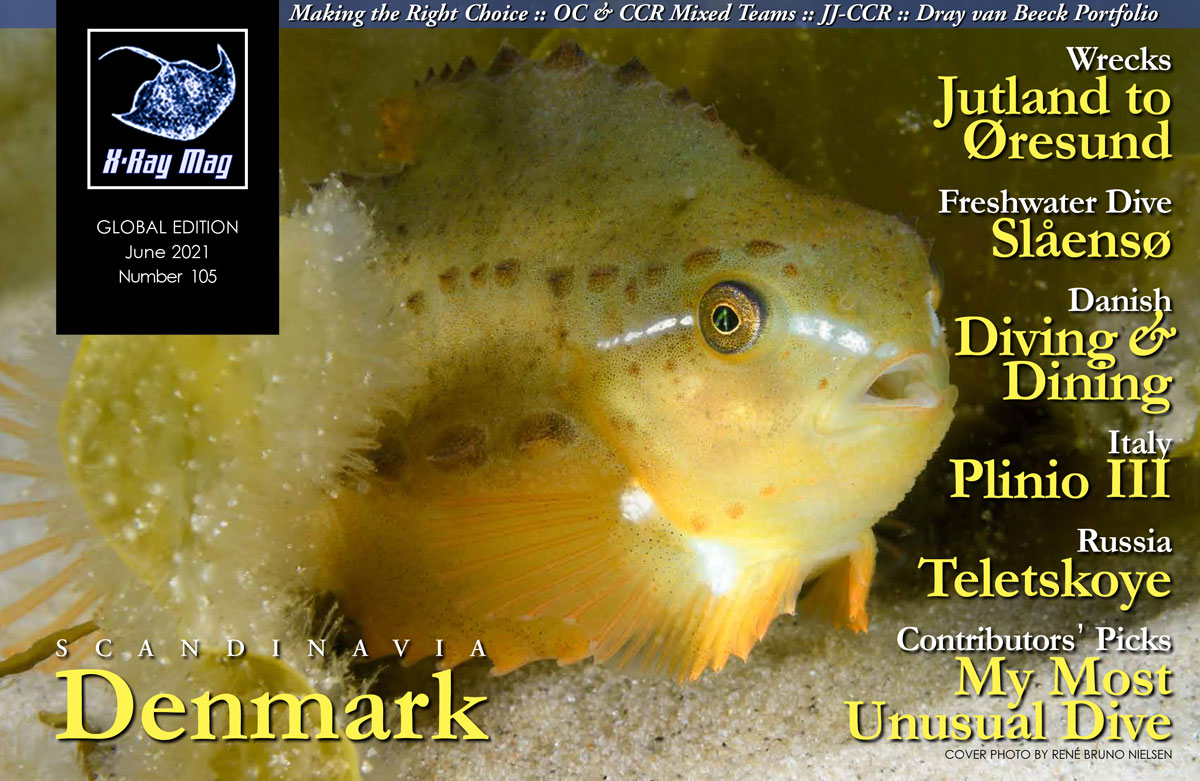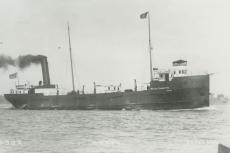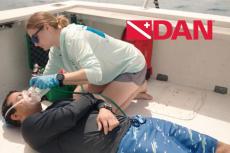Somewhere, far from civilisation, there is a secret place, lost among the high mountains and impassable wild forests. Here, where, for a hundred kilometres, you will not meet another person, there are roaring streams of waterfalls breaking from steep coasts, and in winter, instead of ice-bound lakes and rivers, waves rage. At the same time, in this place, the mysterious dark depths of one of the deepest and largest lakes in Russia attracts hundreds of divers every year. Intrigued? Then we invite you on an adventure to Lake Teletskoye.
Contributed by
In the Altai Mountains, one finds snow-capped peaks, rushing rivers and blue lakes in a green sea of forests and tundra. Few places on earth can compare to its majestic beauty. To preserve the pristine nature of Altai, the Altai Nature Reserve was created in 1932. It is the only specially protected natural area in Russia where diving has been actively developed and supported, as a type of ecotourism, which will not harm the nature found here. With a length of 77km and a depth of 325m, Lake Teletskoye is the largest body of water and reservoir in Altai. It is filled with the legends and myths of the local indigenous people.
Getting there
The road to Altai begins with a flight to Gorno-Altaisk, the capital of the Altai Republic. Then there is a transfer of 200km, in which travellers ride along the mountain ranges and through mountain passes in a rugged vehicle for about four hours. The journey on the road to the lake itself is a pleasant adventure, where you can enjoy scenic views and rich aromas of the taiga, or boreal forest.
At the bottom of the last winding and picturesque descent of the mountainous trail, with an elevation change of one kilometre from the summit to the base, visitors register at a checkpoint entrance (remember, this is a specially protected natural area) and check in to the cosiest spot for divers in Siberia: the village of Yaylu, which is the small original settlement in the area.
Yaylu is also the central estate of the Altai Reserve and is technologically quite developed, with round-the-clock power supply from a diesel-solar power plant, high-speed internet access points and 4G internet connection. In Yaylu, there are no large tourist complexes and no huge numbers of tourists—it’s just a quiet place in the middle of the forest. Divers are accommodated in the comfortable guest houses of local residents. The nature reserve authorities impose certain restrictions: Hunting (including underwater), fishing, bonfires, setting up tents and simply being on the reserve’s territory without permission are prohibited. But this is a small price to pay for preserving Altai’s wilderness for future generations.

About the lake
And now, let’s go to the shore of the main attraction: Lake Teletskoye, also known as Golden Lake. Geologically, Lake Teletskoye is located on a tectonic fault, and its modern shape was formed about 20,000 years ago during the last epoch of glaciation.
One of the most interesting features of the lake is that one can dive in open water here all year round. Teletskoye is one of the few non-freezing freshwater lakes in Russia, completely freezing over only once every six to eight years. However, there can be really severe storms here, with wave heights of up to two metres. Yet, the sound of the surf all winter long is what people come here to enjoy.
The coasts of the Teletskoye are mostly high and steep. There are no roads along the coast, and dive sites are accessible mainly from the water.

Diving
So, how does Lake Teletskoye surprise an experienced diver? Let’s start with the fact that on Teletskoye, every dive is deeper than 15 to 20m and considered a night dive, regardless of the time of day. When diving, one will experience a sensation of falling into an almost palpable blackness, as if you are descending into a thick layer of black ink, where the beams of dive lamps or torches shorten and fade. The only thing that reminds one that the sun still exists is the dim green ceiling when one looks up. At 30m, it also disappears. The visitor enters the realm of eternal darkness.
At depths of more than 40m, darkness always combines with the crystal clarity of the water. Technical diving on Lake Teletskoye is remarkable because—regardless of the season or the weather—at depths below 40m, visibility is limited only by the power of your dive lamp. Silt from the surface does not reach this depth, and the transparency of the water is always good. At the same time, the sensation of diving here can best be described as flying in outer space.
The water temperature in Lake Teletskoye most often varies in a narrow range from 1 to 4°C. In summer, only the first few metres warm up, so drysuits are mandatory. You can dive in the lake all year round. If one does not have experience diving in a drysuit, this is not a problem, as there is a wide range of sizes in drysuits for rent, and a drysuit course can be completed in two days.
Underwater, Lake Teletskoye is a vast sandy, muddy desert, with the play of the sun’s rays in the lake’s shallows, and steep piles of rocks, vertical walls, and a secret night life for fishes in its seemingly unlimited depths with absolutely transparent water clarity.
The underwater landscape along the lake’s shallow coastal strip is usually a plateau with rocks and driftwood overgrown with algae. One can sometimes find really huge trees on the lake bottom. Boulders here are often the size of cars. Then, the mud-and-sand lakebed slopes downward. Deeper down lie massive rocks. On clear, sunny days with good visibility, the landscape sometimes reminds one of endless dunes in the deserts.
At the dive site in Yaylu, divers do a mandatory check-dive. For those who are here for the first time, it is necessary to understand the specific conditions and get used to the features of the reservoir. Here, the shallow water is flooded with sunlight on a clear day. Diving lower, divers will find a fairly steep muddy slope and pass by the remains of a sunken pier built in the early ‘60s from thick pine logs. Now, it serves as a home and shelter for many underwater organisms.
The Yaylu area of the lake is suitable for really deep dives; the slope is quite steep, with vertical stone walls alternating with stepped silted terraces. From 50 to 55m, the muddy slope breaks down to a steep wall and a terrace or cliff at 80m. Below this point, at 100m, there is again a wall, at the foot of which one reaches a gentle plateau. All the horizontal surfaces in the lake are covered with sediment, like fallen snow. In some places, there are traces of the activity of the stream, which carries out into the lake what once grew, bloomed, crawled or flew around it—creating a “layer cake” of dark swathes of leaves, twigs, blades of grass and insects, on top of the sediments on the lakebed.
This is just one dive site, and the variety of underwater landscapes in the lake is impressive: sheer walls of marble and limestone, with remains of wrecks, black underwater rocks, shallow shelves, vertical walls, and in some places, rugged canyons. Sometimes, you will see structures that resemble the superstructures of sunken ships or the spires of Gothic cathedrals.

Seasons
When can you come? The answer is simple: any time. Each time of year has its own characteristics and charms.
Spring. The most pleasant thing for divers in spring is the perfect transparency of the water. In springtime, large waves no longer raise silt near the coastal strip, cold water (2°C) does not allow plankton to actively vegetate, and the rivers flowing into the lake have not yet collected and carried a large enough flow of muddy water to impair visibility at a considerable distance. On sunny days, you can see underwater landscapes for tens of metres into the distance.
In May, the shores of Lake Teletskoye are painted with purple flowers of Ledebur rhododendron; this is the hallmark of the Altai spring. On the lawns, spring flowers successively replace one another—white, purple, yellow and orange.
In the spring, you can also observe fog on the lake as rolling “waves” on the shore, covering not only the mountains on the other side, but also the next few metres, with a dense veil of cloud. The level of the lake at this time rises very quickly, with the water rising by 30cm per day. The lake swallows up four to five metres of shoreline every day, which makes it easier to carry dive equipment to the water. Under the water, there is still an almost wintery coolness in temperature as well as good transparency. Usually, good visibility is maintained until the end of June.
Summer. In summer, a stream of water, muddy with clay, flows through the lake from the Chulyshman River, the main inflow of Lake Teletskoye. From the tops of the mountain slopes, you can see how the river and lake waters mix, forming patterns resembling the pattern of milk foam in a cappuccino. You can observe large accumulations of coniferous pollen on the water; they merge into giant “rivers” that stretch for kilometres. Visibility in the surface layers at this time rarely exceeds two to three metres and improves within a month. In this way, ultrapure mountain water is enriched with minerals and organic matter to continue the cycle of life. Nevertheless, the lake is large, and there are always places where the water remains clear.
Autumn. In the autumn (September to October), you will be greeted by the serenity of early fall. The surface layers of the lake are still warmed up to 9 to 16°C—a pleasant temperature for macro photography and decompression stops. The calm waters hide the life bubbling under the mirror surface of the lake.
Schools of grayling and young pike can always be seen on a night dive, but the most interesting thing to observe takes place in the world of invertebrates. The growth period of freshwater sponges is still ongoing in the fall. Their bright pink colonies grow into bizarre forms, from “bushes” to “fingers” and tree-like shapes. Another feature of early autumn are the underwater carpets of hydra, covering everything everywhere. Dense clusters and tangles of tentacles are found on rocks, wood, metal, and even on other invertebrates. Hydra passengers ride on snails. All of this and much more can be seen by an attentive observer.

Winter. In winter, the lake is dominated by the winds; they bring high waves onto the shore. For lovers of contemplation, Yaylu provides not only the luxury of the sound of the surf and the view of the emerald waves, but also an extensive park of bizarre ice sculptures that are formed by the constant freezing of cold-water spray, falling on rocks and trees. No ice figure park can surpass the creations of nature.
What happens underwater in a storm can be briefly described as a “washing machine,” very noisy and sometimes working around the clock. During storms, raised silt and sand from coastal areas do not allow one to see anything beyond one’s outstretched arm, in the first three metres of a dive. Water fluctuations are felt up to the six-metre mark. At the same depth, the transparency of the water becomes better and better, and at 30m, the diver is met with silence, in the calm and eternal darkness.
At this time of year, the mood of the Golden Lake changes not only from day to day, but also during the course of one day. By the evening, the wind subsides, and it becomes quite a feasible mission to go into the water. The silt quickly settles and visibility in shallow water is restored again.
Ice cover is usually not able to establish itself because of strong winter winds, but sometimes—usually in February, due to the severe cold and rare hours of calm—Lake Teletskoye, although reluctantly, gives in to winter and freezes. A few days after freezing, the transparency of the water can reach 40m, and at a short distance, the water seems almost invisible. The preparation of ice holes is not hard work; the ice is rarely thicker than 30cm and does not cover the lake for more than two months—a great chance to learn ice diving!
Features of local fauna
Undoubtedly, the biodiversity of the lake is typical of cold seas and a minimal food supply due to cold water that is harder to warm, but an attentive observer will always see what is hidden at first glance. The best time to observe the lake’s fauna is at night. Burbot rise from the depths of the lake, grayling can be seen in the shallow waters, and pike (as befits a dominant species of an ecosystem) calmly, and with dignity, patrol their territory, looking with interest at the strange visitors with fins and tanks.
At night, the water near the lake bottom is a “soup” of oar-footed crustaceans and small fishes. Vertical rock surfaces without silt are covered with a carpet of hydra. And on the muddy lakebed, life just boils, even under the ice: Small stonefish jump from place to place; gammarus swarm; leeches wriggle, trying to suck on a new host; cyclops crustaceans quickly hide from the light of dive torches; and hydra slowly hunt them, spreading their long tentacles. All these critters are small and fussy—a real challenge for the macro photographer.
Dive centre
The underwater research station of the Altai Nature Reserve is located on the shore of Lake Teletskoye in the village of Yaylyu. Despite the distance from civilisation, the centre has everything divers need for recreational and technical diving: a tank-filling station, compressors, equipment for preparing gases (oxygen, nitrox, trimix). There are dry and wet areas where you can change clothes and dry your equipment, as well as hot tea (made from local herbs) to drink after winter dives, by the warmth and crackle of a wood-burning stove.
There is also a comfortable classroom where training is conducted, from the beginning level (CMAS, SDI) to the technical (TDI), and all underwater guests are given information about the world of the unique Altai lake. The centre stays open all year round, as its friendly team is constantly in the water.
But the centre’s work is not just about tourism. Regular work is carried out to clean up Lake Teletskoye of illegal and abandoned nets, and garbage. Comprehensive studies of plankton, as the basis of the aquatic ecosystem, and environmental monitoring are carried out.
Research has begun in the field of underwater dendrochronology—submerged wood is of particular interest, as it is a promising repository of information about climate change and past events, and it opens up wide opportunities for dating artefacts. Diving for us is not just work. This is a way of knowing ourselves and the parallel universe on the other side of the water’s surface. ■

The staff of the underwater research station at Lake Teletskoye includes Tatyana Klimenko, instructor of TDI, SDI, CMAS; and Roman Vorobyov, researcher of the Altai Nature Reserve, certified gas-blender, divemaster, trimix diver and doctor. For more information, email: zazerkalie04@yandex.ru, or go to: youtube.com/channel/UCHoMTcD2MnBnUfCloSlLrvQ and facebook.com/AltayskiyZapovednik


































